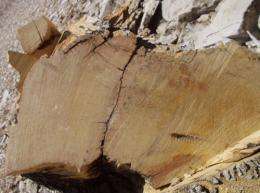Lord of the tree rings

Trees are outstanding historians. In fact, scientists dating back to Leonardo da Vinci recognized the value of trees. While others had figured out that you could determine the age of a tree by counting its growth rings, da Vinci went beyond that basic knowledge.
"He was a genius and realized also that the width of those growth rings carried information about the environmental conditions during each year the rings were formed," says David Stahle, director of the Tree Ring Laboratory at the University of Arkansas.
"So, he really anticipated the entire science of dendrochronology using annual growth rings from trees to infer past environmental variability, especially climate variability," continues Stahle, a professor in the university's Geosciences Department. "The time series of fat rings versus skinny rings is telling you about the history of wet years versus dry years."
Along with colleagues from the National Laboratory of Dendrochronology at the Mexican Forest Research Institute, Stahle collects tree-ring samples from remote forests, far from human influence. With support from the National Science Foundation (NSF), Stahle is now developing tree-ring records of Mexico's climate variability.
"Mexico has suffered persistent drought and we've done research on this using both the instrumental record and tree-ring reconstructions. One notion is that this 21st century drought may be being aggravated by human activity, both at the global scale and at the regional scale due to land surface changes," explains Stahle. "Not only is Mexico vulnerable to water availability, but her hydroelectric power supply system is also vulnerable to climate variations and drought. Mexico has had a notorious history of drought that has interacted with food supply availability, famine and disease, and has resulted in catastrophic population loss in the colonial history of that country."
So how do scientists extract a tree-ring core as thick as a pencil without harming the tree?
The key is a tool called a Swedish increment borer, invented more than 100 years ago to test the growth rate of living trees. It's basically a long, hollow steel auger. "This increment borer can be screwed into the center of the tree and it extrudes a core inside the long drill bit. You then remove the core from the auger with a long thin steel foil called an extraction spoon," Stahle says.
It does take practice and a little elbow grease! But, if done properly there's no permanent damage to the tree. In addition to offering a history of weather, these tree rings also offer some insight into how our ancestors lived, such as the climate extremes they suffered and the construction and abandonment of their settlements. In fact, under a microscope, experts can determine in exactly what year a barbed wire fence made a wound into a tree, helping to settle modern property disputes.
Tree rings may also help solve some of history's mysteries. For example, Stahle believes drought may have played a part in the New World's "Lost Colony" of Roanoke. "This is the drought of 1587, '88, and '89. That was the most severe drought of 800 years in this part of the United States, and 1587 was a particularly significant year because Virginia Dare, the first English baby born in the New World, and the other colonists at the Roanoke colony in North Carolina, were last seen in the summer of 1587," says Stahle, pointing to some extremely skinny rings on a piece of bald cypress from Blackwater River, Virginia.
So what trees do these experts like to study most?
"In the pantheon of tree species for dendrochronology, there are a few that are the crème de la crème, if you will--the very best species in the world. There are a limited number of them and really, in North America, it would be the Douglas fir, especially grown on arid sites in the interior of the continent," says Stahle.
Also among his favorites: ponderosa pine, the southern bald cypress in the United States, and the Montezuma bald cypress in Mexico.
His work also involves the bigger picture of protecting the world's forests. "These forests are being cleared and cut even today because progress marches on. So it's kind of a burden on the dendrochronological community to try to identify these relic old-growth forests that are still found and still threatened in many parts of our country," notes Stahle. "But, it's a great pleasure to travel to remote areas in the United States or Mexico to original forests, even virgin forests, with old growth trees, and there are precious few of these locations left. I think they're aesthetically beautiful; these old growth forests are important from an ecological perspective, and for the climate histories they preserve in their annual rings."
Provided by National Science Foundation














